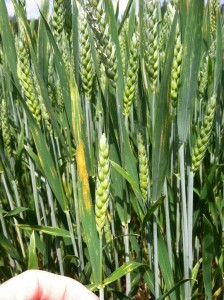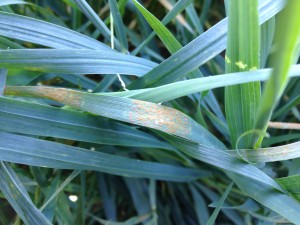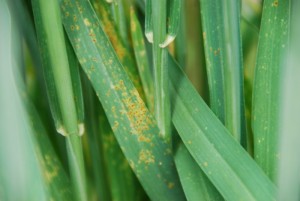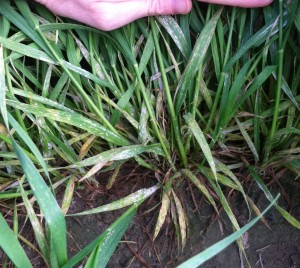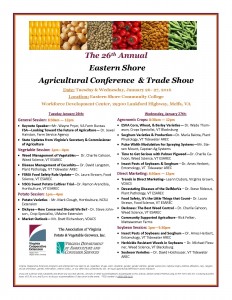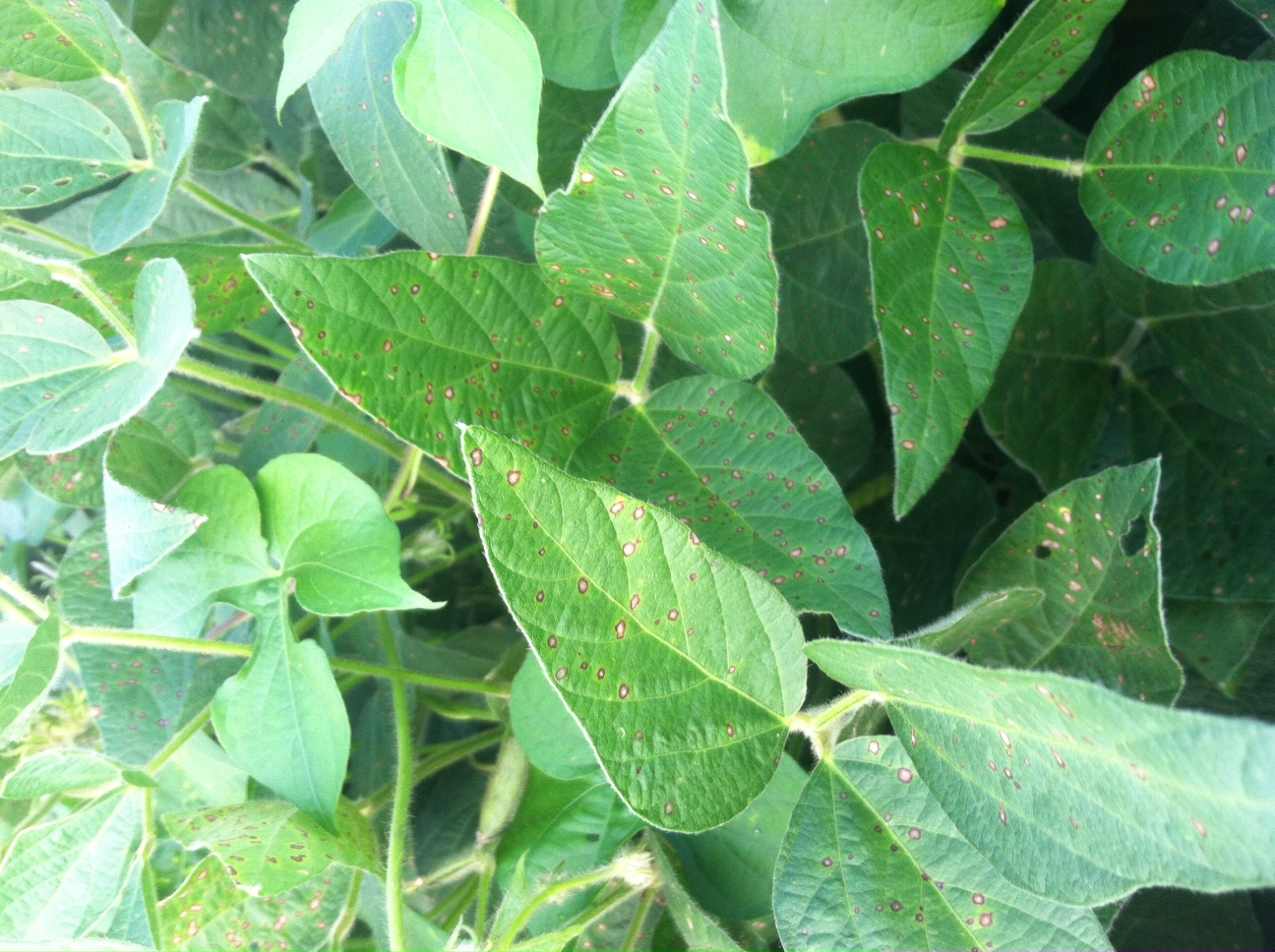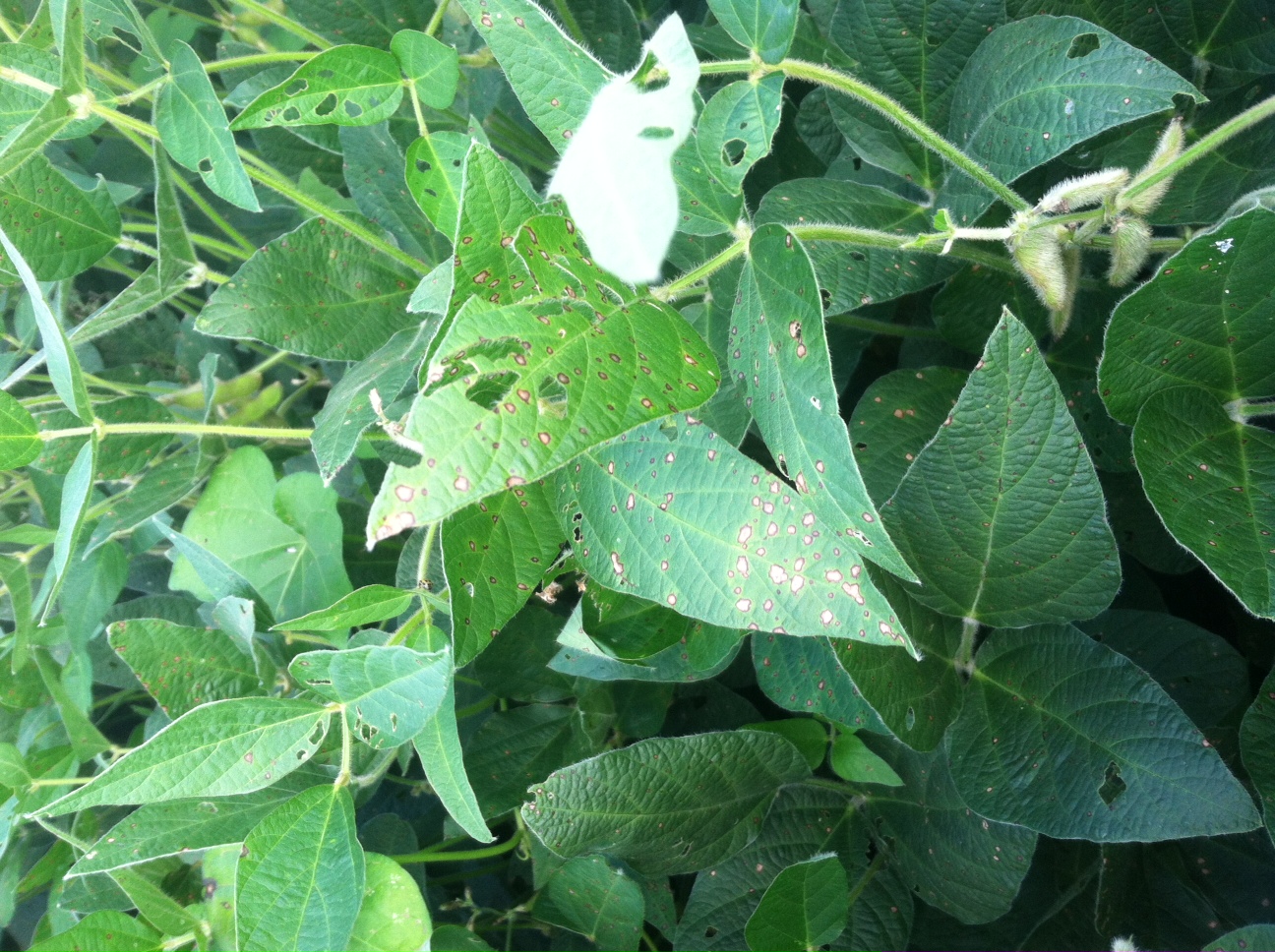Due to the recent rain, scab risk is increasing in portions of Virginia, especially on the Eastern Shore and coastal areas. The scab risk assessment tool can be found at http://www.wheatscab.psu.edu. Many fields are at or near flowering. In most areas, moderately resistant (MR) varieties are in the low to medium scab risk category, but keep in mind that many acres are still planted to moderately susceptible (MS) or susceptible (S) varieties such as Shirley. In the eastern portions of the state, scab risk is projected to be high for susceptible varieties over the next week, and it will likely be necessary to work in fungicide applications between rain events. Fungicides targeting scab should be applied within 5-6 days of flowering (50% of main tillers starting to flower from the center of the head). Do NOT apply a strobilurin or fungicide pre-mix containing a strobilurin after flag leaf emergence (Feekes 9) since this can increase DON contamination in the grain. Prosaro, Caramba, and Proline are the most effective products for reducing scab and DON contamination. These fungicides will also control foliar diseases such as leaf blotch, stripe and leaf rust, and powdery mildew. Stripe rust has been observed on susceptible wheat cultivars in some fields for several weeks now, but levels remained low due to dry conditions. The recent rain and humid conditions have resulted in spread of the disease in some areas. Similar conditions are forecasted over the next week and the disease has the potential to spread rapidly, so growers should scout their fields immediately to determine if stripe rust is present.
Category Archives: Disease
Wheat Disease Update – April 12, 2016
Stripe rust has been found on wheat in southeastern Virginia (Suffolk) and the Eastern Shore (Northampton County). Stripe rust is not observed every year, but it can be more aggressive than leaf rust and spread very quickly if temperatures are moderately warm and humidity/rainfall is high. Many wheat varieties are susceptible, and we do not have good stripe rust ratings for the region because the disease is fairly rare. Pictures showing typical symptoms of leaf rust and stripe rust are below. Fields should be scouted, and keep in mind it is more important to catch stripe rust early than leaf rust. If a field has good yield potential and stripe rust is present, a fungicide application is recommended. In addition to rust, powdery mildew has been reported from throughout Virginia and leaf blotch has been observed in southeastern Virginia, so as the wheat crop approaches the flag leaf emergence growth stage, it is time to start thinking about disease management. For specific fungicide recommendations, see my earlier post (April 7, 2016).
Wheat Disease Update April 7, 2016
As the wheat crop approaches the flag leaf emergence growth stage, it is time to start thinking about disease management. When conditions are conducive to disease development (e.g. high humidity, warm temperatures) foliar fungicide applications may be necessary to protect wheat yield and quality. The mild winter in 2014/2015 resulted in early onset of foliar diseases in some areas, and powdery mildew and rust were reported from a few fields as early as December. Recently, powdery mildew has been reported from throughout Virginia, leaf blotch has been observed in southeastern Virginia, and leaf and stripe rust have been reported just south of Virginia in North Carolina.
Once the flag leaf emerges, this leaf surface, which feeds the developing grain, should be protected from disease if symptoms are observed on the lower leaves and conditions are conducive to disease development. Fungicides containing a strobilurin should not be applied after heading but are a good option for control of foliar diseases as the flag leaf emerges. Late applications of strobilurins can increase DON (vomitoxin) if scab infections occur during flowering. Triazoles including Caramba, Proline, and Prosaro are good options for scab control and will also control late-season foliar disease. Currently, scab risk in the region is low but growers should consult the FHB prediction tool (http://www.wheatscab.psu.edu/) as the crop gets closer to flowering. Ideally, fungicide applications should be made based on scouting and/or risk of infection and disease development due to weather conditions. A fungicide efficacy table for many of the products registered for wheat can be found below.
2016 Wheat Fungicide Efficacy Table
As always, for more information on disease management in field crops feel free to contact Dr. Hillary Mehl, Extension Plant Pathologist by email (hlmehl@vt.edu) or phone (757-657-6450 ext. 423).
APPLIED RESEARCH ON FIELD CROP DISEASE CONTROL 2015
Trial summaries for applied research on field crop disease and nematode control conducted in Virginia in 2015 are now available.
Applied Research on Field Crop Disease Control in Virginia, 2015
26th Annual Eastern Shore of Virginia Ag Conference & Trade Show
The Eastern Shore of Virginia Ag Conference & Trade Show is on! We are snow free, and looking forward to a great event on January 26 and 27, 2016. The event will take place at the Eastern Shore Community College Workforce Development Center in Melfa, VA. The full program can be found at: http://issuu.com/esarec/docs/flipbookfinal/1. We have been approved for Certified Crop Adviser (CCA) CEU credits (details at: https://www.dropbox.com/s/f34f3spg4quni7a/CCA_Credits_Handout_2016.pdf?dl=0), Virginia Nutrient Management Credit (1 credit), and Virginia Pesticide Recertification credits (information in the program). See you there! Directions can be found at: http://es.vccs.edu/about/mapdirections/.
Eastern Shore Ag Conference & Trade Show
Join Virginia Tech, Virginia Cooperative Extension, the Virginia Association of Potato and Vegetable Growers, and Industry to hear updates, research information, and innovative products for grain, oilseed, and vegetable crops important to Virginia’s Eastern Shore on January 26 and 27, 2016. This event is free and open to the public. Announcements concerning conference updates, weather delays and/or closings, etc. will be made at: https://www.facebook.com/EasternShore.Soils. Highlights of the program can be found in the attached flyer.
Soybean Seed Quality Continues to Deteriorate
The warm and wet September combined with early planting of early-maturing varieties have led to some rather severe seed quality problems in soybean this year. Our harvest to date indicates that seed quality in our Northern Piedmont is pretty good, but declines as one moves south. There also seems to be a good correlation with lack of rotation, earlier maturity groups, and earlier planting showing most of the problems. The issues can usually be attributed to the diseases phomopsis seed decay and purple seed stain, which I’ll describe in more detail below. Other diseases such as Alternaria, anthracnose, and frogeye leaf spot can also cause seed discoloration and quality issues, but are less common. The bottom of the plant usually has more seed decay than the top. But if harvest is delayed, the entire plant will be infected.
Phomopsis Seed Decay. When soybeans mature during warm and wet conditions, we can expect seed quality to deteriorate. Because this disease develops more rapidly on plants that are maturing under warm and wet conditions, we usually have more problems with early-maturing varieties. We can however have seed decay on our later- maturing varieties if October is warm. Although pods can be infected earlier, seed decay does not usually begin until after physiological maturity (R7).
Infected seed are shriveled, elongated, and c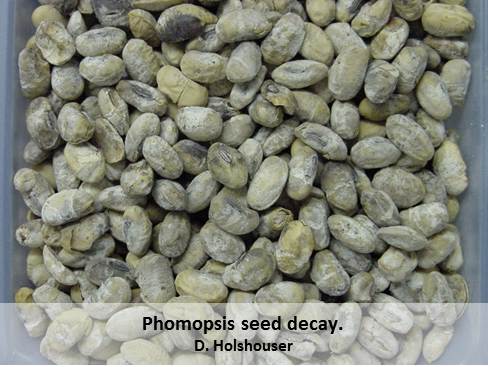 racked. Severely infected seed may appear white and chalky. The fungus secretes enzymes that degrade the seed coat proteins. Test weight can be lower. High occurrence of these seed can lead to discounts or rejection.
racked. Severely infected seed may appear white and chalky. The fungus secretes enzymes that degrade the seed coat proteins. Test weight can be lower. High occurrence of these seed can lead to discounts or rejection.
There are a few things that can be done to reduce the disease incidence. It resides in the soil and on infected residue. So, rotation is very important. More decay will occur in a crop deficient in potassium, infected with viruses, and heavily attacked by insects. Later-maturing varieties and later planting dates that delay maturity into the cooler parts of the year will reduce the incidence. Still, timely harvest is the best management strategy. The longer you leave the soybeans in the field, the worse the disease. So, only plant as many early varieties as you can harvest in a timely manner. Foliar fungicides will decrease the incidence of seed decay if applied from pod development (R3-R4) to early seed filling stages (R5). My experience is that a single R3 will do little to prevent seed decay; it will usually take a second application at R5.
Purple Seed Stain. Purple seed stain is caused by the organism Cercospora kikuchii, the same organism that causes Cercospora blight. Before maturity, fields with Cercospora blight can be recognized by reddish leaves and reddish purple blotches on the stem and leaf petioles. When severe, defoliation of the upper leaves of the plant will take place. In many cases, the blotching progressed up the stem and to the pods. 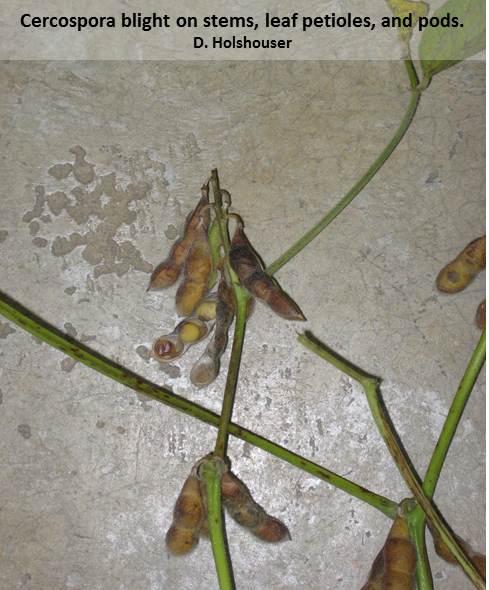 Dark, nearly black pods may appear on some varieties. Once it progresses to the pods, there is a higher likelihood that the seed will be stained.
Dark, nearly black pods may appear on some varieties. Once it progresses to the pods, there is a higher likelihood that the seed will be stained.
Purple seed stain is very noticeable. The seed will contain pink to pale purple to dark purple splotches, which can cover the entire seed coat. The purple stain itself does not reduce yield, but seed with nearly 100% discoloration may be lower in oil and higher in protein. A lot of staining can result in discounts. Germination of seed with 50% or more staining will likely be delayed.
Usually, the disease first appears on the plant during early seed development. If conditions are right (average temperatures over 80o for several days), then the disease will build up rapidly. Other weather factors do not generally affect seed 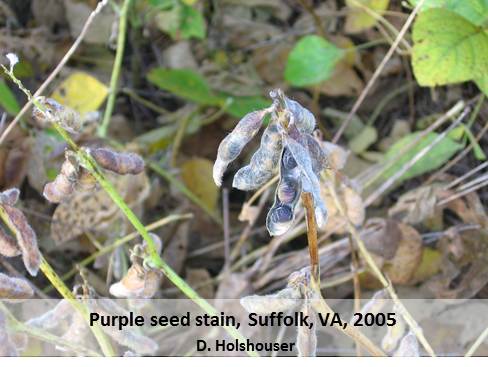 infection. Severity of the infection is largely related to amount of infected leaf debris and residue. Therefore, rotation with a non-legume crop is critical for control.
infection. Severity of the infection is largely related to amount of infected leaf debris and residue. Therefore, rotation with a non-legume crop is critical for control.
Other control measures include variety selection, planting high quality seed free of visual staining, and fungicides. Varieties differ in their susceptibility of Cercospora kikuchii, but that information is rarely available in seed catalogs. We routinely evaluate purple seed stain in our variety tests. Fungicides will give some control if applied during pod or seed formation.
Soybean disease update – frogeye leaf spot
I have received numerous reports of soybean fields with moderate to severe frogeye leaf spot (FLS) over the past several weeks. In most cases, the disease is showing up in fields planted to a FLS susceptible variety and/or in fields that have been in continuous soybean. FLS can cause significant yield loss in susceptible varieties, so fungicides may be needed to control the disease in high risk fields (see accompanying blog post “Foliar fungicide applications in soybean”). Unfortunately, FLS isolates resistant to strobilurin (QoI, Group 11) fungicides have been confirmed from some locations in Virginia, so fungicide control failures can occur if the proper fungicide chemistries are not selected as illustrated in the pictures below. A soybean fungicide efficacy table with ratings based on data from multiple field trials in multiple states can be downloaded below. We are currently surveying fields in Virginia for strobilurin-resistant FLS and will have data on the frequency and distribution of resistance later this year. In the meantime, it should be assumed that FLS will not be controlled by strobilurin fungicides, and other fungicide chemistries (e.g. triazoles) should be applied in fields with FLS either alone or in combination with a strobilurin. Keep in mind that strobilurin fungicides still provide good control of other diseases that can occur in soybean.
Foliar fungicide applications in soybean
If and when to make a foliar fungicide application is a decision soybean producers must make each growing season. Every year is slightly different, and it is difficult to predict whether or not a fungicide application will be profitable. However, the risk factors listed below can be used to make an educated decision of whether or not to spray. The greater the number of risk factors in your field, the more likely it is that a fungicide application will be profitable.
- Growth stage of the crop. Disease is most likely to impact yield during pod and seed development since this is when the yield of the crop is being formed. Fungicides are more likely to result in a yield response if disease occurs between the beginning pod (R3) and full seed (R6) growth stages, a period that lasts approximately 30 days. Results from research conducted in 2014 suggest that a fungicide application is most likely to result in a yield response if weather conditions (see #2 below) conducive for disease development occur within two weeks of the R3/R4 growth stage. Overall, the optimum timing for a fungicide is at the R3/R4 growth stage, though later applications can be beneficial if diseases develop later in the season. Fungicide applications after the R5 growth stage are not recommended.
- Weather conditions. Currently, research is being conducted to develop a weather-based fungicide decision aid for soybean. Infection, growth, and sporulation by foliar pathogens occurs when temperatures are moderately warm and during periods of rainfall or high humidity. To determine the relative disease risk based on weather conditions, find a source of hourly temperature, rainfall, and relative humidity data (e.g. Weather Underground or a personal weather station). If over the past week the following conditions occurred on two or more days, the risk of disease development in the crop is high:
• Average daily temperatures from 65-80 °F AND
• 10 or more hours of relative humidity at or above 95% OR a rainfall event
These conditions have occurred in many areas throughout Virginia over the past week as storms have moved through. However, before making a fungicide application consider the other risk factors below. - Susceptibility of soybean variety to disease. Soybean varieties vary in their susceptibility to diseases, and more susceptible varieties are more likely to need a fungicide to protect yield. Keep in mind that a variety may be relatively resistant/tolerant to one or a few diseases but susceptible to others, so be aware of which diseases are most likely to occur in your field (see #4 and #5 below).
- Field history. Soybean debris is a source of pathogen inoculum, so diseases will show up earlier and be more severe in fields planted to soybean year after year compared to those in rotation with corn or another crop. History of a particular disease in a field should also be considered since it is likely to occur year after year.
- Confirmation of disease in a field. If you see a foliar disease starting to develop in your soybean crop, it may be a sign that it is time to apply a fungicide. Scouting may be useful for some diseases such as frogeye leaf spot, but other diseases (e.g. Cercospora blight) do not show symptoms until long after infections have occurred. Fungicides are more effective when applied preventatively, but applications shortly after the onset of symptoms will slow the progress of the disease. Thresholds have not been established for frogeye leaf spot or other foliar diseases of soybean.
- Yield potential. This year some soybean fields got off to a poor start and never really recovered. If growth is poor and yield potential is low, you do not have much yield to protect and fungicide applications are less likely to be profitable. In contrast, if a crop has high yield potential, a fungicide application can help to maximize that yield, especially if the variety is susceptible to disease.
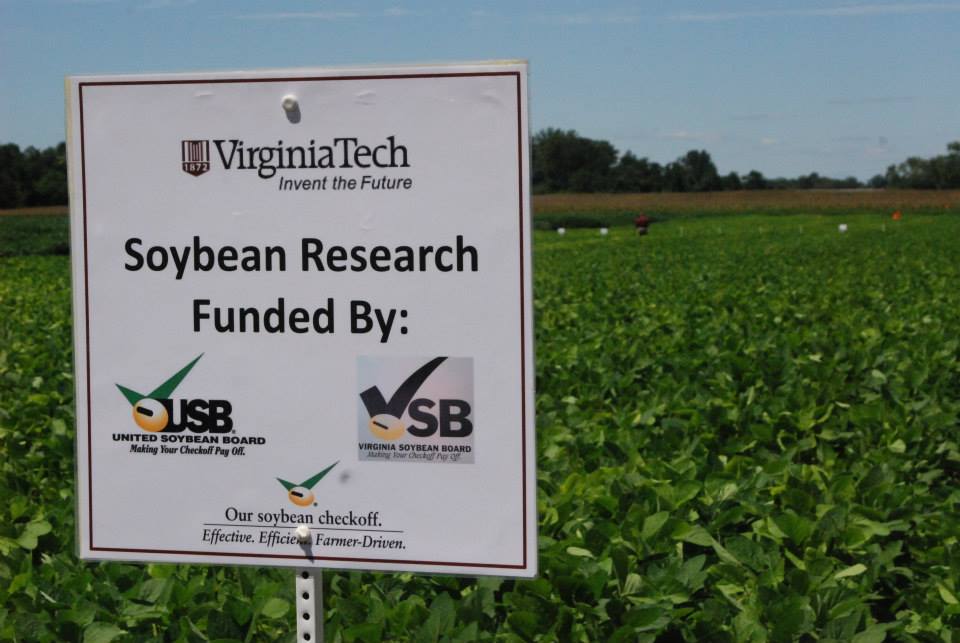
The Virginia Soybean Field Day is this Thursday
VIRGINIA SOYBEAN FIELD DAY
Thursday August 20, 2015
Eastern Virginia Agricultural Research & Extension Center
2229 Menokin Road
Warsaw, VA 22572
(804) 333-3485
Sponsored by
Virginia Soybean Association
Virginia Agricultural Experiment Station
Virginia Cooperative Extension
Join us to see the latest research on soybean varieties, disease and weed management, IPM and sorghum varieties. Experts will also demonstrate no-till drill maintenance and update you on the mid-Atlantic double crop initiative. Registration begins at 8:00 am and field tours begin at 8:50 am. The program will end at noon with a delicious meal by Nixon Catering.
Topics include:
– Soybean Disease Management – Dr. Hillary Mehl
– Soybean Weed Management – Dr. Mike Flessner
– Soybean Insect IPM – Mr. Mike Parish and Drs. Sean Malone and Ames Herbert
– No-Till Drill Maintenance – Mr. Keith Burgess
– Grain Sorghum Management – Dr. Joseph Oakes
– Roundup-Ready Public Soybean Varieties – Dr. Bo Zhang
– Mid-Atlantic Double-Crop Soybean Initiative – Dr. David Holshouser
We hope to see you there!

